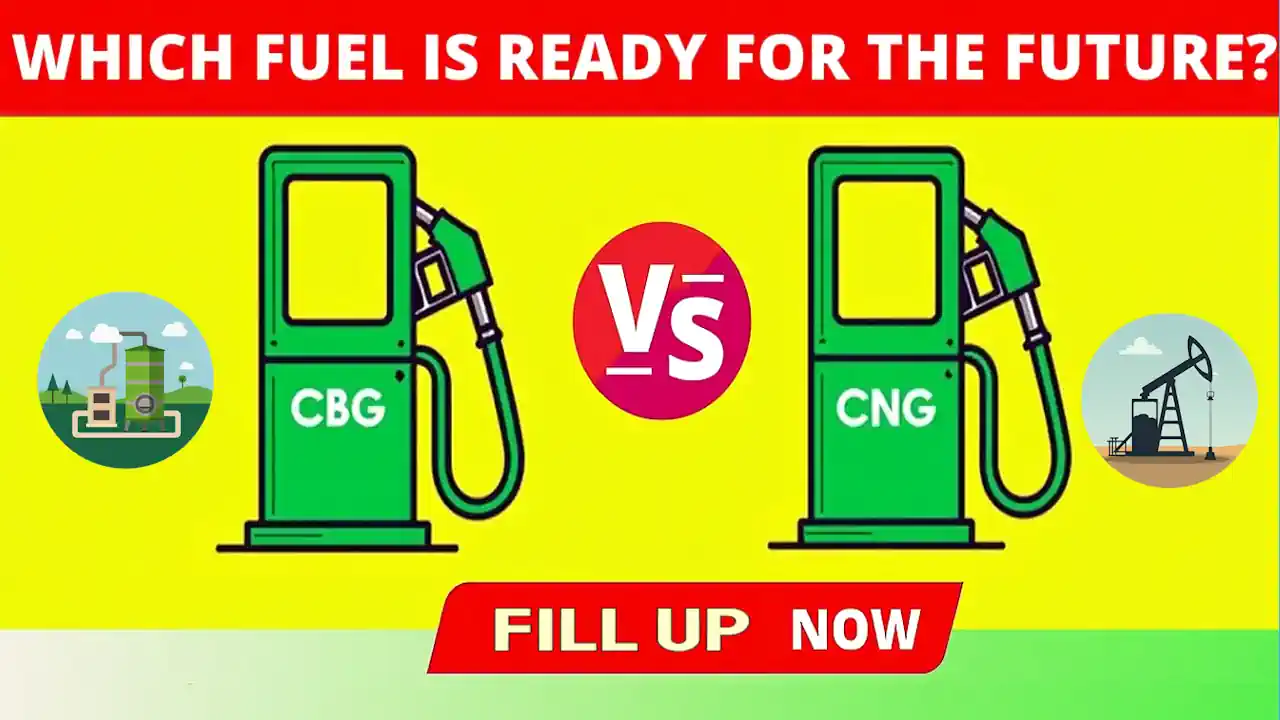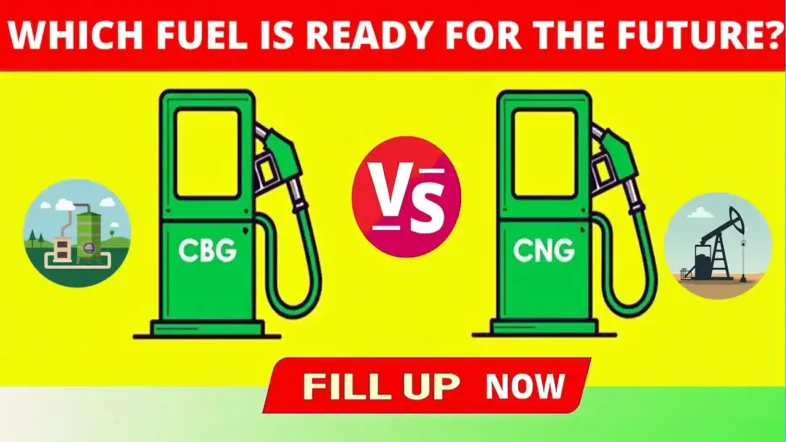When comparing Biogas vs CNG the first point to be aware of is that we will be comparing purified biogas (biomethane) and Compressed Natural Gas (CNG), both consist almost wholly of methane but differ significantly in their origin and environmental impact. CNG is a fossil fuel extracted from underground reserves, making it a non-renewable resource with associated carbon emissions when burned. Biogas (or compressed biogas, CBG), on the other hand, is a renewable fuel produced from the anaerobic digestion of organic matter like agricultural waste and sewage.
Key Takeaways – Biogas vs CNG
- Biogas is renewable and produced from organic waste, making it more environmentally friendly than CNG, which is derived from fossil fuels.
- While CNG offers a more established infrastructure and higher energy density, biogas provides superior carbon reduction benefits, reducing emissions by up to 90% compared to fossil fuels.
- Converting organic waste into biogas creates a circular economy benefit that addresses both waste management and energy production challenges.
- The production cost of biogas has decreased by 30% in the last decade, making it increasingly competitive with conventional CNG.
- Both fuels can be used interchangeably in many applications after biogas is upgraded to biomethane, providing flexibility for consumers seeking cleaner energy alternatives.
The Future of Fuel: Biogas vs CNG
The global shift toward sustainable energy has put alternative fuels like biogas and Compressed Natural Gas (CNG) in the spotlight. As we face growing climate concerns and depleting fossil fuel reserves, understanding the differences between these two energy sources becomes crucial for making informed decisions. Energy Transition Partners has been at the forefront of analyzing these alternative fuels to help consumers and businesses make sustainable choices that benefit both their operations and the environment.
Both biogas and CNG offer significant advantages over traditional petroleum-based fuels, but they differ fundamentally in their origins, production methods, and environmental impacts. This comprehensive comparison will explore these differences to help you determine which fuel aligns better with your environmental goals and practical needs.
- Biogas: A renewable fuel produced from organic waste materials
- CNG: A fossil fuel composed primarily of methane that's compressed for efficient storage
- Both: Cleaner alternatives to gasoline and diesel with lower emissions
- Key differences: Source sustainability, carbon footprint, infrastructure requirements, and production costs

What You Need to Know at a Glance
Before diving into the details, it's important to understand that biogas and CNG are not competing technologies but rather complementary solutions in our transition to a more sustainable energy future.
Biogas represents a fully renewable pathway, while CNG serves as an important bridge fuel with existing infrastructure advantages. Your specific circumstances, including location, available resources, and intended applications, will largely determine which option makes more sense for your needs.
How Biogas and CNG Are Made: Production Processes Compared
The production methods for biogas and CNG reveal fundamental differences that impact their sustainability profiles and availability. Understanding these processes helps explain why biogas generally offers superior environmental benefits despite CNG's current market advantages.
Biogas Production: From Waste to Energy
Biogas emerges from the natural breakdown of organic materials in oxygen-deprived environments. This process, called anaerobic digestion, occurs when microorganisms consume organic matter such as food waste, agricultural residues, sewage, or manure. The resulting gas consists primarily of methane (50-75%) and carbon dioxide (25-50%), along with trace amounts of other gases.
Modern biogas production typically takes place in purpose-built digesters that optimize conditions for methane-producing microbes. These controlled environments accelerate the natural decomposition process, allowing for efficient capture of the biogas.
This captured gas can be used directly for heat and electricity generation or upgraded to biomethane (also called renewable natural gas or RNG) by removing CO2 and impurities to achieve a methane content of over 95%.

CNG Production: Refining Natural Gas
Compressed Natural Gas starts as conventional natural gas extracted from underground deposits formed over millions of years. These fossil deposits are predominantly methane, though they contain varying amounts of other hydrocarbons and impurities depending on the source.
The extracted gas undergoes processing to remove contaminants like water vapor, hydrogen sulfide, and heavier hydrocarbons.
Once purified, the natural gas is compressed to less than 1% of its volume at standard atmospheric pressure (typically to 3,000-3,600 psi). This compression is what gives CNG its name and makes it practical for transportation and storage.
The energy-intensive compression process represents a significant portion of CNG's production carbon footprint.
Key Production Differences That Impact Environmental Footprint
The fundamental distinction between biogas and CNG lies in their sources: biogas comes from renewable organic materials that would otherwise decompose and release methane to the atmosphere, while CNG derives from finite fossil fuel reserves. This difference creates biogas's circular economy advantage, where waste becomes a valuable resource rather than an environmental burden.
The timeframe of carbon cycling also differs dramatically. The carbon in biogas was recently captured by plants through photosynthesis, creating a short carbon cycle that doesn't add new greenhouse gases to the atmosphere. Conversely, CNG releases carbon that has been stored underground for millions of years, contributing to a net increase in atmospheric carbon dioxide when burned.
“The carbon neutrality of biogas represents one of its most significant advantages over fossil-derived alternatives. When organic waste decomposes naturally, it releases methane regardless. By capturing and utilizing this methane as biogas, we're not only preventing a potent greenhouse gas from entering the atmosphere but also displacing fossil fuels that would otherwise be used.” – International Renewable Energy Agency
“Compressed Natural Gas (CNG …” from www.linkedin.com and used with no modifications.
Cost Analysis: Which Fuel Makes More Economic Sense?
When comparing biogas and CNG from a financial perspective, several factors come into play beyond the simple per-unit cost. The economic equation involves initial capital investment, operational expenses, available subsidies, and long-term price stability considerations.
Production Costs for Biogas vs CNG
Historically, CNG has maintained a cost advantage due to economies of scale and established infrastructure. The production cost of CNG typically ranges from $0.50 to $1.20 per gasoline gallon equivalent (GGE), depending on natural gas prices and regional factors. This relatively stable pricing has made CNG attractive for fleet operators seeking predictable fuel costs.
Biogas production costs have traditionally been higher, ranging from $1.00 to $3.00 per GGE, but this gap is narrowing significantly. Technological improvements and increasing scale of biogas operations have driven down costs by approximately 30% over the past decade. When waste disposal savings are factored in, biogas can actually become the more economical option in many scenarios.
The economic equation shifts dramatically when factoring in externalized costs like environmental damage and climate impact. With carbon pricing mechanisms becoming more common globally, biogas's minimal carbon footprint translates to substantial savings in jurisdictions with carbon taxes or cap-and-trade systems.
- CNG production costs: $0.50-$1.20 per GGE
- Biogas production costs: $1.00-$3.00 per GGE (but decreasing)
- Carbon pricing advantages favor biogas by $0.10-$0.40 per GGE in regions with carbon taxes
- Waste disposal savings can offset biogas production costs by $0.50-$1.50 per GGE
- Long-term price stability is greater with biogas due to independence from fossil fuel markets
Infrastructure Requirements and Expenses
CNG benefits from decades of natural gas infrastructure development, including extensive pipeline networks, compression stations, and established distribution systems.
For organizations looking to switch to CNG, this existing infrastructure significantly reduces barriers to entry. However, biogas infrastructure is catching up rapidly, with many utilities now accepting upgraded biogas (biomethane) into existing natural gas pipelines, effectively leveraging the same distribution infrastructure.
Government Incentives and Subsidies
Government policies heavily influence the cost competitiveness of both fuels. In many regions, biogas receives preferential treatment through renewable energy credits, carbon credits, and direct subsidies. These incentives can dramatically improve the economics of biogas projects, sometimes making them more financially attractive than CNG operations despite higher production costs.
The policy landscape continues to evolve in favour of truly renewable solutions like biogas. For example, the Renewable Fuel Standard (RFS) in the United States and similar programs in the European Union assign premium values to biogas-derived fuels through tradable credits.
These programs can add $0.50 to $1.50 per GGE in additional value for biogas producers, effectively neutralizing the production cost advantage of conventional CNG.
![]()
“Biogas / Bio-CNG/ CBG / RNG industry …” from biogas-india.com and used with no modifications.
Performance and Efficiency in Different Applications
Performance characteristics of biogas and CNG differ slightly due to their compositional variations, though these differences become minimal once biogas is upgraded to biomethane standards.
Both fuels offer distinct advantages over traditional petroleum fuels in many applications, but their specific performance profiles can make one more suitable than the other depending on the use case. For instance, the methane digester story highlights efficient biogas waste management, showcasing the potential of biogas in specific applications.
Energy density represents one of the most significant performance distinctions. CNG typically contains more energy per volume than raw biogas due to its higher methane concentration.
However, upgraded biogas (biomethane) achieves nearly identical energy content to CNG, eliminating this differential in most commercial applications.
| Performance Metric | Raw Biogas | Upgraded Biogas (Biomethane) | CNG |
|---|---|---|---|
| Methane Content | 50-75% | 95-98% | 87-99% |
| Energy Content (BTU/scf) | 500-650 | 950-1000 | 900-1100 |
| Octane Rating | N/A (raw form not used in vehicles) | 120-130 | 120-130 |
| CO2 Emissions (g/mile)* | N/A | 25-40 | 200-230 |
| *When accounting for lifecycle emissions, not just tailpipe |
Both fuels burn more cleanly than gasoline or diesel, producing fewer particulates, sulfur compounds, and nitrogen oxides. This cleaner combustion translates to reduced maintenance needs and extended engine life in most applications.
The high octane rating (120-130) of both fuels also allows for higher compression ratios in optimized engines, potentially improving thermal efficiency.
From a practical perspective, upgraded biogas and CNG can be used interchangeably in most applications. This compatibility means that as biogas availability increases, existing CNG infrastructure and equipment can transition seamlessly to the more sustainable fuel source without requiring new investments.
Vehicle Performance Comparison
In vehicle applications, drivers typically cannot distinguish between CNG and biomethane performance. Both fuels deliver similar range, power, and drivability characteristics when used in properly designed or converted vehicles.
The slightly lower energy density compared to gasoline means that dedicated natural gas vehicles require larger fuel tanks to achieve comparable range, but this limitation affects both CNG and biomethane equally.
The primary performance difference lies not in the driving experience but in the environmental impact. Vehicles running on biomethane can achieve near carbon-neutral or even carbon-negative operation, depending on the feedstock used to produce the biogas.
This makes biomethane-powered vehicles significantly more effective at reducing greenhouse gas emissions than their CNG counterparts, despite similar driving characteristics.

“Romeo CBG June 25 – YouTube” from www.youtube.com and used with no modifications.
Industrial and Commercial Uses
In industrial settings, both fuels excel in applications requiring consistent, clean-burning thermal energy. Food processing, textile manufacturing, and other industries that rely heavily on process heat can benefit from either fuel. The choice often comes down to local availability, contract pricing, and organizational sustainability goals rather than performance differences.
For commercial enterprises with sustainability commitments, biogas offers distinct advantages through its significantly lower carbon footprint and potential for positive brand association.
Many companies are willing to pay premium prices for biogas as part of their corporate social responsibility initiatives, recognizing that the environmental benefits outweigh marginally higher costs. For example, BrewDog Brewery has made significant strides in making biogas carbon negative.
Residential Applications
For home use, both fuels can provide heating, cooking, and hot water through existing natural gas appliances. The consumer experience remains identical whether the methane delivered to homes comes from fossil sources or organic waste digestion.
This seamless substitution capability makes biomethane an attractive option for utilities looking to decarbonize their gas supply without requiring customers to replace appliances or modify their energy usage patterns.
5 Key Advantages of Biogas Over CNG
While both fuels offer environmental benefits compared to traditional petroleum products, biogas holds several distinct advantages over CNG that make it the superior choice for organizations and individuals committed to sustainability.
These advantages extend beyond simple emissions reductions to encompass broader environmental and social benefits.
1. Renewable Source Material
The fundamental advantage of biogas lies in its renewable nature. Unlike CNG, which depletes finite fossil fuel reserves, biogas is produced from continuously generated organic waste streams. Agricultural residues, food waste, sewage, and animal manure—all renewable resources—serve as feedstocks for biogas production.
This renewable characteristic ensures that biogas can be produced indefinitely without resource depletion, providing true energy sustainability that CNG fundamentally cannot match. For more insights, explore how biogas is made from food waste.
2. Waste Reduction Capabilities
Biogas production transforms problematic waste streams into valuable energy resources, addressing two environmental challenges simultaneously.
By diverting organic materials from landfills or traditional waste management systems, biogas production reduces methane emissions that would otherwise occur during natural decomposition.
This waste-to-energy approach reduces the burden on landfills, mitigates odor and contamination issues associated with organic waste, and creates economic value from materials previously considered disposable.
3. Lower Carbon Footprint
“When produced from organic waste materials, biogas can reduce greenhouse gas emissions by 80-90% compared to fossil fuels. This dramatic reduction comes not only from displacing fossil fuel use but also from preventing the methane emissions that would have occurred if the organic matter had decomposed naturally in landfills.” – International Energy Agency Bioenergy Task 37
The carbon footprint advantage of biogas over CNG is substantial and multifaceted. When accounting for full lifecycle emissions, biogas produced from waste materials can be carbon-negative, meaning it actually removes more greenhouse gases from the atmosphere than it generates.
This remarkable environmental benefit occurs because methane emissions that would have been released during natural decomposition are instead captured and utilized.
CNG, while cleaner than coal or oil, still contributes significant net carbon emissions to the atmosphere. The methane in CNG has been sequestered underground for millions of years, and its combustion adds new carbon dioxide to the atmospheric carbon cycle.
Even with efficient extraction and minimal leakage, CNG's carbon footprint typically ranges from 60-80% of conventional petroleum fuels—far higher than biogas.
The methane captured in biogas production would have eventually converted to atmospheric CO2 through natural processes anyway.
By capturing and using this methane as fuel, biogas systems prevent the release of methane (which has 25-28 times the global warming potential of CO2) while displacing fossil fuels that would have added new carbon to the atmosphere.
For organizations with carbon reduction targets or those operating in jurisdictions with carbon pricing, biogas offers a clear pathway to meaningful emissions reductions that CNG simply cannot match.
The carbon advantage becomes even more pronounced when biogas is produced from waste streams that would otherwise generate significant methane emissions, such as animal manure or food waste.
4. Local Production Potential
Biogas can be produced virtually anywhere organic waste is available, enabling distributed energy generation that strengthens local economies and energy resilience.
This decentralized production potential contrasts sharply with CNG, which relies on centralized extraction operations and extensive distribution infrastructure.
Local biogas production reduces transportation emissions, creates jobs in rural communities, and builds energy independence at the regional level—benefits that extend far beyond the direct environmental advantages of the fuel itself.
5. Circular Economy Benefits
Biogas exemplifies circular economy principles by recapturing the energy and nutrient value in organic materials. Beyond the energy output, biogas production creates nutrient-rich digestate that can be used as a sustainable fertilizer, returning valuable phosphorus, nitrogen, and other nutrients to agricultural soils.
This closed-loop system contrasts with the linear “extract-use-dispose” model of fossil fuels like CNG, providing cascading environmental benefits throughout the value chain.
By creating value from waste, biogas systems incentivize better management of organic materials throughout the economy. This ripple effect can transform waste management practices across sectors, creating environmental benefits that extend far beyond the direct emissions reductions from the fuel itself.

“Scania 460 R GAS LBG & CBG Tractor …” from www.youtube.com and used with no modifications.
3 Situations Where CNG Outperforms Biogas
Despite biogas's impressive environmental credentials, CNG maintains several practical advantages that make it the preferred choice in specific scenarios. Understanding these situations helps identify where CNG might be the more pragmatic option, even for environmentally conscious consumers and organizations.
1. Consistent Supply Chain
CNG benefits from a mature, reliable supply chain built over decades of natural gas industry development. This established supply infrastructure ensures consistent availability and quality regardless of seasonal variations or local conditions.
For operations where fuel supply reliability is mission-critical, such as emergency services or essential transportation, CNG's stable supply chain provides security that biogas production may not yet match in all regions.
Biogas production, particularly from agricultural feedstocks, can experience seasonal fluctuations based on harvesting schedules and organic waste availability.
While storage systems and diversified feedstock strategies can mitigate these variations, organizations requiring absolute certainty in fuel availability may find CNG's supply consistency advantageous in the short term.
2. Established Infrastructure
The extensive natural gas infrastructure already in place globally gives CNG a significant practical advantage in many regions.
Fueling stations, pipelines, storage facilities, and compatible equipment are widely available for CNG, reducing the barriers to adoption for new users. This established infrastructure makes CNG the more accessible option in areas where biogas production and distribution systems remain underdeveloped.
3. Higher Energy Density
Raw biogas contains less energy per volume than CNG due to its lower methane content and the presence of CO2 and other gases.
While upgraded biogas (biomethane) achieves nearly identical energy density to CNG, the additional purification process increases costs and complexity. In applications where maximum energy density is critical and upgrading facilities aren't available, CNG may provide practical advantages.
For long-haul transportation or remote operations where refueling opportunities are limited, CNG's higher energy density in its standard form can translate to extended range and operational flexibility.
This advantage diminishes as biogas upgrading technologies become more widespread and cost-effective, but remains relevant in certain specialized applications.
It's worth noting that these advantages primarily reflect the current state of infrastructure and technology rather than inherent limitations of biogas. As biogas production scales up and infrastructure develops, many of these practical advantages of CNG will likely diminish over time.
- CNG requires less specialized equipment for storage and distribution
- More abundant fueling locations currently exist for CNG vehicles
- CNG has more established quality standards and certification processes
- Vehicle manufacturers have more extensive experience with CNG systems
- CNG currently enjoys broader regulatory frameworks and industry standards
Making the Right Choice for Your Energy Needs
Choosing between biogas and CNG requires balancing environmental priorities with practical considerations.
For most applications, the decision framework should consider immediate operational needs alongside long-term sustainability goals, recognizing that the optimal solution may evolve as technology and infrastructure develop.
A comprehensive assessment should examine not only the direct costs and performance characteristics but also the broader environmental impacts, organizational sustainability commitments, and regional policy landscapes that might influence the economics of each option.
In many cases, a phased approach that begins with CNG but transitions toward biogas as it becomes more readily available provides a practical pathway to sustainability.
Decision Factors Based on Application
Different applications have distinct priorities that influence the biogas versus CNG decision. Fleet operators typically prioritize total cost of ownership, fuel availability, and operational reliability—areas where CNG currently has advantages in many regions.
However, organizations with strong sustainability commitments or those seeking to market their environmental credentials may find biogas's superior carbon profile worth the potential premium or additional complexity.
Industrial users should consider not only the direct fuel costs but also potential synergies with waste management needs.
Companies generating significant organic waste streams may find that on-site biogas production creates valuable integration opportunities that improve the overall economics beyond the simple fuel cost comparison with CNG.
Regional Availability Considerations for Biogas vs CNG
Geography plays a crucial role in determining the viability of each fuel option. Regions with strong agricultural sectors or significant food processing industries typically have greater biogas potential due to abundant feedstock availability.
Conversely, areas with extensive natural gas infrastructure but limited organic waste resources may find CNG the more practical near-term solution while building toward greater biogas integration as regional production capacity develops.
The Future of Biogas and CNG in a Renewable Energy World
As global energy systems transition toward sustainability, both biogas and CNG will play important but evolving roles. CNG is likely to serve as a bridge fuel, providing immediate emissions reductions compared to petroleum while infrastructure and technology for fully renewable alternatives develop.
Biogas, meanwhile, is positioned to become an increasingly important component of a fully renewable energy system, especially in sectors difficult to electrify like heavy transport, industrial process heat, and seasonal energy storage.
The long-term trajectory clearly favors biogas as production scales up, costs decline, and climate policies increasingly value its superior environmental profile.
Organizations making energy infrastructure decisions today should consider this evolving landscape, potentially designing systems compatible with both fuels to facilitate an eventual transition to the more sustainable option.
Biogas vs CNG – Frequently Asked Questions
Below are answers to some of the most common questions about biogas and CNG. These responses address practical considerations for individuals and organizations evaluating these alternative fuels for their operations.
Can biogas be used in regular CNG vehicles without modifications?
Yes, upgraded biogas (biomethane) can be used in any CNG vehicle without modifications. Once biogas has been purified to remove CO2, hydrogen sulfide, and other contaminants, it becomes chemically nearly identical to CNG.
The resulting biomethane meets the same quality standards as conventional natural gas and performs identically in CNG engines and fuel systems.
This compatibility is one of biomethane's greatest advantages, allowing organizations to transition to renewable fuel without vehicle fleet modifications.
Vehicles designed or converted to run on CNG can seamlessly switch to biomethane, making it possible to gradually increase the renewable content of the fuel supply without requiring any changes to existing vehicles.
How much cheaper is biogas compared to CNG?
The price comparison between biogas and CNG varies significantly by region and is influenced by multiple factors, including local natural gas prices, available subsidies, carbon pricing mechanisms, and biogas production scale.
In regions without supportive policies, CNG typically remains 10-30% cheaper than biomethane on a direct price comparison. However, in jurisdictions with carbon taxes, renewable fuel standards, or other supportive policies, biomethane can achieve price parity or even cost advantages.
The economics are continuously evolving as biogas production technologies improve and achieve greater economies of scale. In the past five years, production costs for biomethane have declined approximately 30% at large-scale facilities, narrowing the price gap with conventional CNG.
This trend is expected to continue, with some projections suggesting biomethane could achieve unsubsidized price parity with CNG in many markets within the next decade.
For organizations with waste management costs, the equation changes dramatically. When biogas is produced from waste streams that would otherwise incur disposal costs, the effective price can be substantially lower than CNG.
Some agricultural and food processing operations have achieved payback periods of 3-5 years on biogas investments through combined savings on waste management and energy costs.
“When accounting for the full cost picture—including waste management savings, carbon credits, and renewable energy incentives—biogas can already be the more economical option for many organizations today. The direct fuel price comparison misses much of the economic value that biogas creates across multiple aspects of operations.” – American Biogas Council (Biogas vs CNG)
What types of waste can be used to produce biogas?
Virtually any organic material can serve as feedstock for biogas production, though the methane yield varies significantly by source. Common feedstocks include animal manure, food waste, crop residues, wastewater sludge, and specifically grown energy crops.
The highest methane yields typically come from materials with high fat or carbohydrate content, while woody biomass with high lignin content is less suitable without pre-treatment.
The versatility of biogas production systems allows for combining multiple feedstock types, often improving overall gas production and system stability. Many commercial biogas operations now use co-digestion strategies that blend complementary waste streams to optimize both methane production and digester operation.
This flexibility makes biogas production adaptable to local waste resources, enhancing its potential for distributed implementation across diverse geographic and economic contexts.
Is CNG truly a clean fuel or just cleaner than gasoline?
CNG represents an improvement over conventional petroleum fuels but falls short of being truly “clean” in absolute terms. When burned, CNG produces approximately 20-30% less carbon dioxide than gasoline and significantly lower amounts of particulate matter, nitrogen oxides, and sulfur compounds.
However, it remains a fossil fuel that contributes to climate change through both combustion emissions and methane leakage during production and distribution.
The environmental benefit of CNG should therefore be understood as relative rather than absolute—it's a cleaner option than petroleum fuels but not a comprehensive solution to transportation-related environmental impacts in the way that biomethane or renewable electricity can be.
How difficult is it to set up a small-scale biogas plant for home or farm use?
Small-scale biogas systems have become increasingly accessible for farms, rural households, and small businesses with appropriate organic waste streams.
Pre-fabricated digester systems designed for farm-scale operations can be installed with moderate technical expertise, typically requiring investments of $50,000-250,000 depending on size and sophistication.
These systems can achieve payback periods of 5-7 years through energy savings and waste management cost reductions, particularly when supported by agricultural grants or renewable energy incentives.
The complexity of installation and operation depends significantly on the intended use of the biogas. Systems producing gas only for heating or cooking are substantially simpler than those designed to generate electricity or produce vehicle fuel.
Basic systems require minimal daily maintenance once operational, typically involving feeding the digester, monitoring gas production, and occasional system checks.
Regulatory requirements vary by location but have generally become more accommodating for small-scale biogas as its benefits gain recognition.
Many agricultural extension services now offer technical assistance for farmers interested in biogas production, helping navigate permitting requirements and system design considerations.
For those interested in exploring small-scale biogas production, connecting with existing operators through biogas associations or agricultural networks provides valuable practical insights beyond the technical specifications.
These peer connections often prove crucial for successful implementation, offering guidance on feedstock management, seasonal operation adjustments, and maintenance best practices that might not be covered in technical manuals. For example, learning about anaerobic digestion plants can provide further understanding of biogas systems.
Biogas vs CNG – Conclusion
The journey toward sustainable energy encompasses many pathways, with biogas and CNG each playing important but distinct roles.
As you evaluate these options for your specific needs, consider not just today's infrastructure limitations but tomorrow's environmental imperatives. Energy Transition Partners can help you navigate these choices to find the optimal solution for both your immediate operational needs and long-term sustainability goals.





